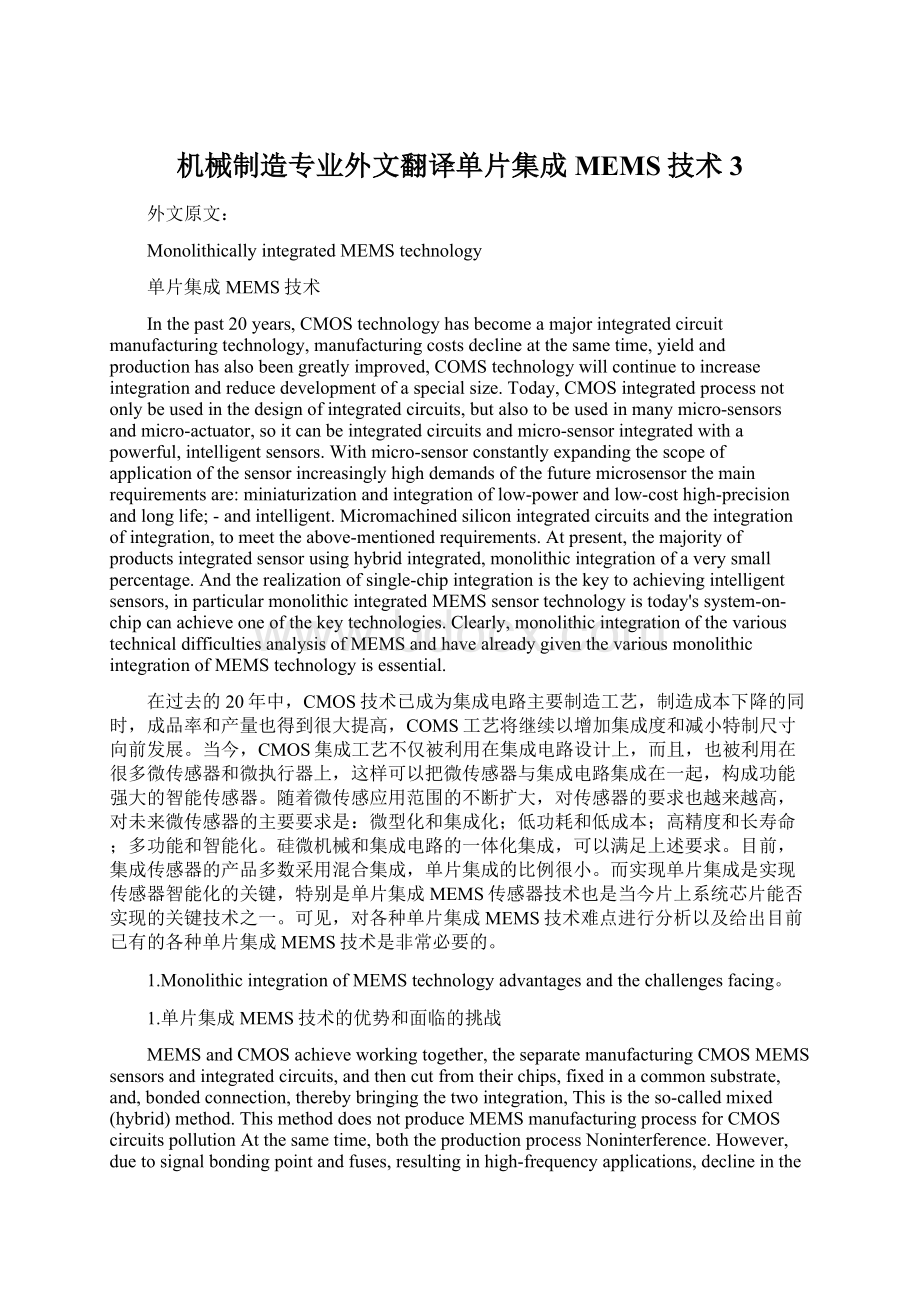机械制造专业外文翻译单片集成MEMS技术3Word格式.docx
《机械制造专业外文翻译单片集成MEMS技术3Word格式.docx》由会员分享,可在线阅读,更多相关《机械制造专业外文翻译单片集成MEMS技术3Word格式.docx(10页珍藏版)》请在冰豆网上搜索。

ssystem-on-chipcanachieveoneofthekeytechnologies.Clearly,monolithicintegrationofthevarioustechnicaldifficultiesanalysisofMEMSandhavealreadygiventhevariousmonolithicintegrationofMEMStechnologyisessential.
在过去的20年中,CMOS技术已成为集成电路主要制造工艺,制造成本下降的同时,成品率和产量也得到很大提高,COMS工艺将继续以增加集成度和减小特制尺寸向前发展。
当今,CMOS集成工艺不仅被利用在集成电路设计上,而且,也被利用在很多微传感器和微执行器上,这样可以把微传感器与集成电路集成在一起,构成功能强大的智能传感器。
随着微传感应用范围的不断扩大,对传感器的要求也越来越高,对未来微传感器的主要要求是:
微型化和集成化;
低功耗和低成本;
高精度和长寿命;
多功能和智能化。
硅微机械和集成电路的一体化集成,可以满足上述要求。
目前,集成传感器的产品多数采用混合集成,单片集成的比例很小。
而实现单片集成是实现传感器智能化的关键,特别是单片集成MEMS传感器技术也是当今片上系统芯片能否实现的关键技术之一。
可见,对各种单片集成MEMS技术难点进行分析以及给出目前已有的各种单片集成MEMS技术是非常必要的。
1.MonolithicintegrationofMEMStechnologyadvantagesandthechallengesfacing。
1.单片集成MEMS技术的优势和面临的挑战
MEMSandCMOSachieveworkingtogether,theseparatemanufacturingCMOSMEMSsensorsandintegratedcircuits,andthencutfromtheirchips,fixedinacommonsubstrate,and,bondedconnection,therebybringingthetwointegration,Thisistheso-calledmixed(hybrid)method.ThismethoddoesnotproduceMEMSmanufacturingprocessforCMOScircuitspollutionAtthesametime,boththeproductionprocessNoninterference.However,duetosignalbondingpointandfuses,resultinginhigh-frequencyapplications,declineinthequalityofsignaltransmission,andtodeveloptwoproductionlinestoincreasethecostoftheproduct.Inordertoaddresssomeperformanceissues,andlowermanufacturingcosts,andproposedtodointhepartofMEMSandCMOScircuitswithasubstrate,whichisproducedcompatiblewithCMOStechnologyormonolithicintegratedMEMStechnologycalledCMOS-MEMStechnology.Thismethodrelativehybridmethodgenerallyhavethefollowingadvantages:
First,theperformancecanbegreatlyimproved,becauseparasiticcapacitanceandcrosstalkphenomenoncanbesignificantlyreduced;
second,hybridmethodrequiressophisticatedtechnologytoreducepackagingSensorInterfaceaffected,andmonolithicintegrationrequirespackagingtechnologyisrelativelysimpleandtherefore,lowercostsensors;
third,monolithicintegratedsensorarraysensortechnologyistheneedtoovercomethearraysensorandexternaldecodingcircuitaneffectiveinterconnectbottleneck;
Fourth,thedevelopmentofmonolithicintegratedmixeddevelopmentofMEMSproductsthanMEMSproductsforashorttime,andtodeveloplowcost.
实现MEMS和CMOS共同工作是分别制造MEMS传感器和CMOS集成电路,然后,从各自的晶片切开,固定在一个共同的衬底上,并且,连线键合,这样就实现两者的集成,这就是所谓的混合(hybrid)方法。
这种方法不会产生MEMS制造过程对CMOS电路的污染,同时,两者生产过程互不干扰。
但是,由于信号经过键合点和引线,导致在高频应用时,信号传输质量下降,并且,开发两套生产线增加了产品的成本。
为了解决一些性能问题,并降低制造成本,提出把MEMS部分做在和CMOS电路同一块衬底上,也就是产生了与CMOS工艺兼容单片集成MEMS技术或叫CMOS-MEMS技术。
这种方法相对混合方法总的来说有如下优势:
第一,性能能得到很大的提高,因为寄生电容和串扰现象可以显著减小;
第二,混合方法需要复杂的封装技术以减小传感器接口的影响,而单片集成方法需要的封装技术相对简单,所以,降低传感器成本;
第三,单片集成传感器技术也是阵列传感器的需要,是克服阵列传感器与外围译码电路互连瓶颈的一种有效方法;
第四,开发单片集成MEMS产品比开发混合MEMS产品所需的时间短,而且,开发成本低。
MonolithicintegrationofMEMStechnologyundersomeofMEMSdevicesandCMOScircuitcanbedividedintodifferentorderprocessingbeforeCMOS(pre-CMOS),mixedCMOS(intermediate-CMOS),andaftertheCMOS(post-CMOS)integratedapproach.
单片集成MEMS技术根据MEMS器件部分与CMOS电路部分加工顺序不同可以分为前CMOS(pre-CMOS)、混合CMOS(intermediate-CMOS)及后CMOS(post-CMOS)集成方法。
Post-CMOSapproachisintheprocessingofsiliconCMOScircuitsEnd,throughsomeadditionalMEMSmicro-processingtechnologytoachievemonolithicintegratedMEMSsystem,atpresent,monolithicintegrationofMEMStechnologyinthiswaymainlybased.Post-CMOSapproachisthemainissueonMEMSprocessingtemperatureCMOScircuitperformanceinfrontofanimpactonmoreseriousisthatthetechnologybehindhigh-temperatureMEMSprocessingtemperatureandmetalCMOSprocessaheadofincompatibility.InthepresentstudyasthemostpolysiliconlayerstructureoftheMEMSexample,thedensificationofphosphorusglassannealingtemperatureis950℃duetoastructuralpolysiliconlayerofstressannealingtemperaturereached1050℃,whichwillenableCMOSdevicesjunctiondepthmigrationoccurred.Inparticular800℃shallowjunctiondevicesjunctiondepthmigrationwillaffectdeviceperformance.Ontheotherhand,theconventionalaluminummetallizationprocess,whenthetemperaturereaches400-450℃,thereliabilityofCMOScircuitswillbeseverelyaffected.Fromtheabovewecanseethat:
howtoovercomebehindhigh-temperatureMEMSprocessingtemperatureonthemicro-structureofthefrontendprocessinghasbeentheimpactofCMOScircuitsintegratedMEMSsingle-chipsolutioniskeytothesystem.Atpresent,theinternationalcommunityisessentialtoresolvethisissuethroughthreeways:
Firstistheinterconnectionofrefractorymetalsinsteadofaluminummetalinterconnect,forexample,theUniversityofBerkeleytoreplacetungstenaluminummetalinterconnectprogrammes,suchfollow-upincreasedtoleranceMEMSprocessingforhightemperature;
Thesecondisproducedbyfindinglowtemperaturemechanicalpropertiesandexcellentsubstitutematerialsasstructuralpolysiliconlayer;
thirdwayistouseitsexistingstructureCMOSMEMSlayerasalayerstructure.
post-CMOS方法是在加工完CMOS电路的硅片上,通过一些附加MEMS微细加工技术以实现单片集成MEMS系统,目前,单片集成MEMS技术主要以这种方法为主。
post-CMOS方法主要问题是MEMS加工工艺温度会对前面的CMOS电路性能产生影响,更为严重的是后面高温MEMS加工工艺温度与前面CMOS工艺金属化不兼容。
以目前研究最多的多晶硅作为结构层的MEMS为例,使磷硅玻璃致密化退火温度为950℃,而使作为结构层多晶硅的应力退火温度则达到1050℃,这将使CMOS器件结深发生迁移。
特别是800℃时浅结器件的结深迁移就会影响器件的性能。
另一方面,采用常规铝金属化工艺时,当温度达到400-450℃时,CMOS电路可靠性将受到严重的影响。
从以上可以看出:
如何克服后面高温MEMS微结构加工温度对前面的已加工完的CMOS电路影响是解决单片集成MEMS系统关键所在。
目前,国际上解决这个问题基本是通过3种方式:
第一种是以难熔金属化互连代替铝金属化互连,如,伯克利大学的以钨代替铝金属互连方案,这样提高容忍后续加工MEMS所需的高温;
第二种方式是通过寻找低制作温度且机械性能优良的材料代替多晶硅作为结构层材料;
第三种方式是利用CMOS本身已有结构层作为MEMS结构层。
Pre-CMOSintegratedapproachistocreatestructureMEMSmanufacturingCMOScircuits,althoughthisintegratedCMOStechnologytoovercomepost-CMOSmethodofhigh-temperatureMEMSTechnologyonCMOScircuitsaffected,butbecauseoftheexistenceofmicro-verticalstructure,andtherefore,theresensorandcircuitinterconnectionlevelcoverage,butalsointheprocessofCMOScircuitsonthemicro-structureprotectionisalsoaneedtoconsidertheissue.Evenfine-tunetheoptimizationofCMOSprocess,suchas:
gateoxidemaybeheavilydopedlayerimpactofthestructure.Inaddition,theMEMStechnologycannotprocessanyofthemetalorothermaterials,suchaspiezoelectricpolymers,andsoon,makesthismethodonlysuitableforsomespecialapplications.
pre-CMOS集成方法是先制造MEMS结构后制造CMOS电路,这种集成CMOS技术虽然克服post-CMOS方法中MEMS高温工艺对CMOS电路的影响,但由于存在垂直的微结构,所以,存在传感器与电路互连台阶覆盖性问题,而且,在CMOS电路工艺过程中对微结构的保护也是一个需要考虑的问题。
甚至已优化微调的CMOS工艺流程,例如:
栅氧化可能被重掺杂的结构层影响。
另外,MEMS工艺过程中不能有任何的金属或其他的材料,如压电材料聚合物等,使得这种方法只适合一些特殊应用。
Intermediate-CMOScircuitsintheCMOSproductionprocesstoinsertsomeMEMSmicro-processingtechnologytoachievemonolithicintegratedMEMSapproach.Thisapproachhasbeenverymatureandhavealotofcommercializationofproducts,isthefirststudyofasingle-chipintegrationmethodistosolvethepre-andpost-CMOSCMOSmethodeffectivemethodproblems,butduetotheneedfortheexistingstandardCMOSorlargerBiCMOSprocesschanges,therefore,theuseofthismethodislimited.
intermediate-CMOS是在CMOS电路生产过程中插入一些MEMS微细加工工艺来实现单片集成MEMS的方法。
这种方法已很成熟,并已有很多商品化产品,也是研究最早一种单片集成方法,是解决pre-CMOS和post-CMOS方法存在问题有效方法,但是,由于需要对现有的标准CMOS或BiCMOS工艺进行较大的修改,因此,这种方法的使用有一定限制。
1.ThemainmonolithicintegratedMEMStechnologystatus
单片集成MEMS的主要技术现状
Atpresent,themonolithicintegrationofMEMStechnologymainlytopost-CMOStechnologies,throughaseriesofcompatiblewithCMOSprocessonthesurfacemicro-machiningandprocessingtoachievemonolithicintegrationofMEMS.Canbedividedintotwokinds:
oneisinthetoplayerCMOSstructuretoastructurelayerdepositionmicro-machining;
theotherisdirectlyCMOSlayerstructureastheoriginalstructureoftheMEMSmicro-machined.
目前,单片集成MEMS技术主要以post-CMOS技术为主,通过一系列的与CMOS工艺兼容的表面微细加工和体加工实现单片集成MEMS。
又可分为2种:
一种是在CMOS结构层上面再淀积一层结构层的微加工;
另一种是直接以CMOS原有的结构层作为MEMS结构层的微加工。
2.1DepositionofnewstructuralmaterialsforthestructureofintegratedMEMStechnology
2.1淀积新的结构材料作MEMS结构的集成技术
2.1.1Polysiliconlayerstructureasthesurfacemicro-machiningtechnologyintegration
2.1.1多晶硅作为结构层的集成表面微细加工技术
ThisprocessistypicalofmodulesdevelopedattheUniversityofBerkeleyIntegratedCMOSandMEMSTechnology(modularintegrationofCMOSwithmicro-structures,MICS),thismethodisforthemicro-structuralpolysiliconlayer,phosphorussiliconglass(PSG)asasacrificiallayerThesurfacemicro-machiningtechnology.Arefractorymetaltungstenmetalinterconnectinsteadofaluminummetalinterconnecttobearbehindthepolysiliconproductionneedsofmicro-s